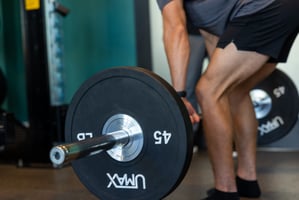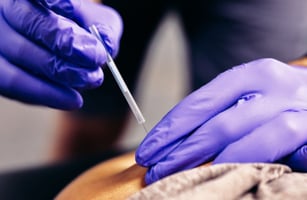Youth sports play a crucial role in building confidence, teamwork, and physical health. However,...
Rally Against Pain: Tennis Elbow and Physical Therapy
Rally Against Pain: Tennis Elbow and Physical Therapy
As a performance Physical Therapist and a former collegiate athlete, I've always had a deep-rooted passion for sports and physical activity. Throughout my life, I've explored various sports and activities, constantly seeking new challenges and opportunities to compete. In recent years, I've developed a particular interest in racquet and paddle sports, including pickleball, racquetball, and tennis. Living in Wilmington, I've been impressed by the abundance of tennis and pickleball courts in the area. It's clear that these sports have gained immense popularity in recent years, with millions of people worldwide picking up a racket or paddle. The Wilmington area is no exception, with countless courts and players of all ages and skill levels. However, the increased participation in racquet sports has also led to a rise in injuries, including the condition known as tennis elbow. Many players, both casual and competitive, have had to take a break or even stop playing their sport due to this painful injury.
Understanding Tennis Elbow
Tennis elbow, also known as lateral epicondylitis, is a common overuse injury that often affects the outside of the elbow. It occurs due to inflammation or microtears in the tendon that connects the forearm muscles to the bone. While the condition is often associated with tennis players, it can affect anyone who engages in repetitive wrist and forearm movements.
The primary muscles involved in lateral epicondylitis include the Extensor Carpi Radialis brevis, Extensor Carpi Ulnaris, and Extensor Digitorum. These muscles are responsible for extending the wrist and hand. In addition to the muscles, the radial nerve, which provides sensation and motor function to the forearm and hand, can also be affected in cases of lateral epicondylitis (Tennis Elbow).
Causes of Tennis Elbow
- Repetitive motions: Activities that involve repeated wrist and forearm movements, such as playing tennis, golf, or using a computer mouse, can put stress on the tendon and lead to inflammation.
- Poor technique: Incorrect form or technique during activities can increase the strain on the tendon.
- Overuse: Excessive or prolonged activity can contribute to the development of tennis elbow.
- Weak forearm muscles: Weak forearm muscles can make it difficult to absorb the stress of repetitive movements, increasing the risk of injury.
- Age: As we age, our tendons can become less resilient, making them more susceptible to injury.
Common Ways to Develop Tennis Elbow
- Sports: Tennis, pickleball, racquetball, and other sports involving racquet or paddle use are common culprits.
- Occupation: Jobs that require repetitive wrist and forearm movements, such as construction, painting, and typing, can increase the risk.
- Hobbies: Activities like gardening, knitting, and carpentry can also contribute to the development of tennis elbow.
Why is Physical Therapy important and what happens when tennis elbow is left untreated
- Chronic pain: The pain associated with tennis elbow can become chronic, lasting for months or even years.
- Weakening of the forearm muscles: Untreated tennis elbow can cause the forearm muscles to weaken, making it difficult to perform daily activities.
- Limited range of motion: The condition can restrict your ability to move your wrist and forearm, affecting your overall hand function.
- Increased risk of tendon rupture: In severe cases, untreated tennis elbow can increase the risk of the tendon tearing.
- Difficulty with daily activities: Tennis elbow can make it painful to perform simple tasks like opening doors, carrying groceries, or typing.
Physical therapy plays a crucial role in managing tennis elbow and reducing the risk of further injury. By strengthening the forearm muscles and improving flexibility, physical therapy can help decrease pain, increase muscle and tendon strength, and reduce the risk of future injuries. Additionally, physical therapists can provide guidance on proper technique and biomechanics, helping you to excel in your sport and minimize the strain on your elbow.
To help alleviate pain, tissue work can help desensitize and decrease the muscle tone. Try the soft tissue exercise below, it should be slightly uncomfortable, not painful.
- Use a lacrosse ball or mobility ball and place it on the tender part of the forearm. Begin to roll the ball back and forth over the tender muscles with slight pressure for 30 seconds at a time.
(Perform over the area of a tender muscle and both sides of the forearm)
To increase strength with Tennis Elbow, eccentrics are important for building tendon and muscle strength. An eccentric contraction is focusing on the lowering phase with tempo and resisting the weight or resistance through the movement. Eccentrics are also known as negatives. Below are eccentric exercises that will help develop forearm and tendon strength.
If you're experiencing or continue to experience elbow pain, seek the expert care of a Physical Therapist. Our team at Conquer Movement specializes in working with athletes and can help you get back to doing what you love. Contact us today to schedule a FREE discovery call and start your journey to a pain-free life!
Dr. Evan Langley DPT, PT, CSCS
Performance Physical Therapist
Conquer Movement - Wilmington, NC

-Edit.jpeg?width=50&name=1Q3A9799(2)-Edit.jpeg)



